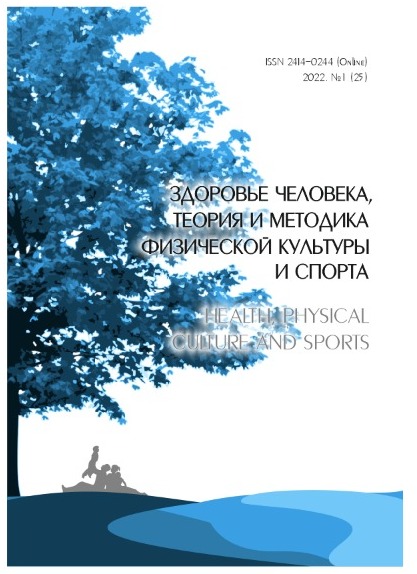Complex application of muscle contraction modes to improve postural control in multiple scle
Abstract
The purpose of this study is to test the effectiveness of postural multimodal training with combined use of muscle contraction modes for multiple sclerosis. A 41-year-old woman with very low physical activity and remmitting multiple sclerosis followed the proposed training program for 5 months, exercising mainly once a week and and several times two workouts (three weeks). The training program included exercises in an unstable standing posture, on an unstable object (bolster), strength exercises without additional weights for the lower and upper body. Postural balance testing was performed using the Berg scale and wall sit, also evaluated functional independence in moving up the stairs. The results shows of the effectiveness of the method for improving dynamic and static postural control, as well as increased functional performance in climbing and descending stairs. A combination (or hybrid) method using three modes of muscle contraction as a form of multimodal training may be recommended for individuals with multiple sclerosis in order to improve postural control.
Downloads
References
Gurfinkel V., Cacciatore T.W., Cordo P., Horak F., Nutt J., and Skoss R. (2006). Postural muscle tone in the body axis of healthy humans. J. Neurophysiol. 96, 2678–2687. DOI: 10.1152/jn.00406.2006.
Horak F.B. (2006). Postural orientation and equilibrium: what do we need to know about neural control of balance to prevent falls? Age Ageing 35 (Suppl. 2), ii7–ii11. DOI: 10.1093/ageing/afl077.
Shadmehr R. (2017). Distinct neural circuits for control of movement vs. holding still. J. Neurophysiol. 117, 1431–1460. DOI: 10.1152/jn.00840.2016.
Ivanenko Y and Gurfinkel VS (2018) Human Postural Control. Front. Neurosci. 12:171. DOI: 10.3389/fnins.2018.00171.
Kluzik J., Horak F.B. and Peterka R.J. (2005). Differences in preferred reference frames for postural orientation shown by after-effects of stance on an inclined surface. Exp. Brain Res. 162, 474–489. DOI: 10.1007/s00221-004-2124-6.
Cameron M.H., Lord S. Postural Control in Multiple Sclerosis: Implications for Fall Prevention. Curr Neurol Neurosci Rep 10, 407–412 (2010). DOI: 10.1007/s11910-010-0128-0.
Soyuer F, Mirza M, Erkorkmaz U. Balance performance in three forms of multiple sclerosis. Neurol Res 2006, 28:555–562. DOI: 10.1179/016164105X49373.
Cattaneo D, Jonsdottir J. Sensory impairments in quiet standing in subjects with multiple sclerosis. Mult Scler 2009, 15:59–67. DOI: 10.1177/1352458508096874.
Daley M. L., Swank R. L. Changes in postural control and vision induced by multiple sclerosis. Agressologie 1983, 24:327–329. https://pubmed.ncbi.nlm.nih.gov/6638322.
Ramdharry G.M., Marsden J.F., Day B.L., Thompson A.J.: Destabilizing and training effects of foot orthoses in multiple sclerosis. Mult Scler 2006, 12:219–226. DOI: 10.1191/135248506ms1266oa.
Frzovic D., Morris M.E., Vowels L. Clinical tests of standing balance: performance of persons with multiple sclerosis. Arch Phys Med Rehabil 2000, 81:215–221. DOI: 10.1016/s0003-9993(00)90144-8.
Diener H.C., Dichgans J., Hulser P.J., et al. The significance of delayed long-loop responses to ankle displacement for the diagnosis of multiple sclerosis. Electroencephalogr Clin Neurophysiol 1984, 57:336– 342. DOI: 10.1016/0013-4694(84)90156-1.
Jackson R. T., Epstein C. M., De l’Aune W. R. Abnormalities in posturography and estimations of visual vertical and horizontal in multiple sclerosis. Am J Otol 1995, 16:88–93. https://pubmed.ncbi. nlm.nih.gov/8579184.
Williams N.P., Roland P. S., Yellin W. Vestibular evaluation in patients with early multiple sclerosis. Am J Otol 1997, 18:93–100. https://pubmed.ncbi.nlm.nih.gov/8989958.
Lanzetta D., Cattaneo D., Pellegatta D., Cardini R.: Trunk control in unstable sitting posture during functional activities in healthy subjects and patients with multiple sclerosis. Arch Phys Med Rehabil 2004, 85:279–283. DOI: 10.1016/j.apmr.2003.05.004.
Benedetti M.G., Piperno R., Simoncini L., et al. Gait abnormalities in minimally impaired multiple sclerosis patients. Mult Scler 1999, 5:363–368. DOI: 10.1177/135245859900500510.
Crenshaw S.J., Royer T. D., Richards J. G., Hudson D.J. Gait variability in people with multiple sclerosis. Mult Scler 2006, 12:613–619. DOI: 10.1177/1352458505070609.
Panjabi M.M.: The stabilizing system of the spine. Part II. Neutral zone and instability hypothesis. J Spinal Disord 5:390–396, 1992. DOI: 10.1097/00002517-199212000-00002.
Sandroff B.M., Bollaert R.E., Pilutti L.A., Peterson M.L., Baynard T., Fernhall B., McAuley E., Motl R.W. Multimodal exercise training in multiple sclerosis: Arandomized controlled trial in persons with substantial mobility disability. Contemp Clin Trials. 2017 Oct; 61:39-47. DOI: 10.1016/j.cct.2017.07.016.
Ali A. S., Darwish M.H., Shalaby N.M., Abbas R.L., Soubhy H.Z. Efficacy of core stability versus task oriented trainings on balance in ataxic persons with multiple sclerosis. A single blinded randomized controlled trial. Mult Scler Relat Disord. 2021 May;50:102866. DOİ: 10.1016/j.msard.2021.102866.
Soysal Tomruk M., Uz M.Z., Kara B., İdiman E. Effects of Pilates exercises on sensory interaction, postural control and fatigue in patients with multiple sclerosis. Mult Scler Relat Disord. 2016 May;7:70- 3. DOİ: 10.1016/j.msard.2016.03.008.
Eftekharsadat B., et al. 2015. Effect of virtual reality-based balance training in multiple sclerosis. Neurol. Res. 37 (6), 539–544. DOİ: 10.1179/1743132815Y.0000000013.
Copyright (c) 2022 Health, physical culture and sports

This work is licensed under a Creative Commons Attribution-NonCommercial 4.0 International License.
An author should not normally publish manuscripts describing essentially the same research in multiple journals or publication venues. Such redundant publication is generally considered to constitute unethical publishing behavior, and if discovered may result in a manuscript under consideration being rejected, or a published article being retracted.
Authors of manuscripts reporting on original research should present an accurate account of the work performed, accompanied by an objective discussion of its significance. Underlying data should be represented accurately in the manuscript. The manuscript should contain sufficient detail and references to permit others to replicate the work. The fabrication of results and the making of fraudulent or knowingly inaccurate statements constitute unethical behavior and may be cause for rejection or retraction of a manuscript or published article.





